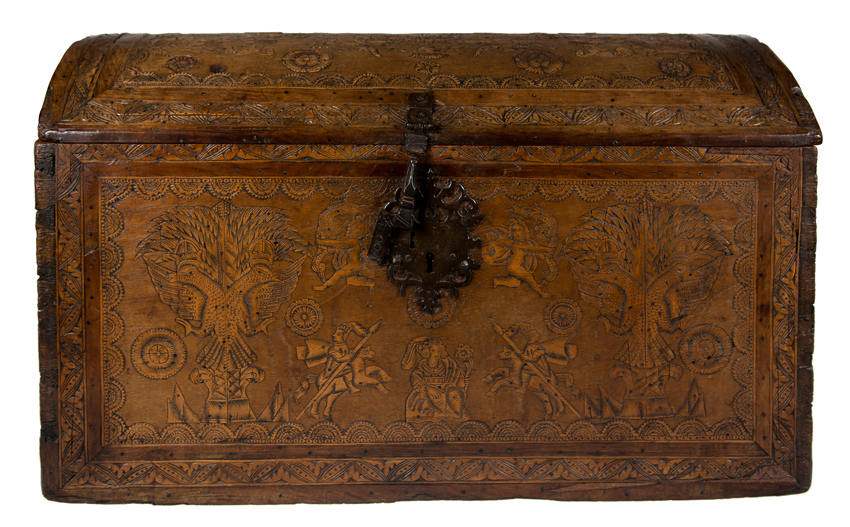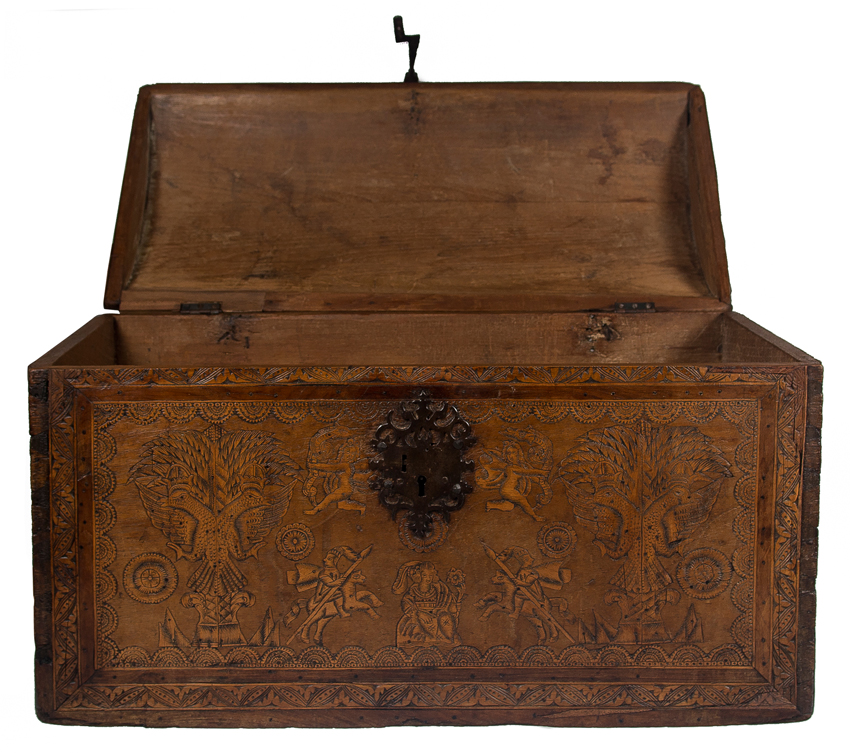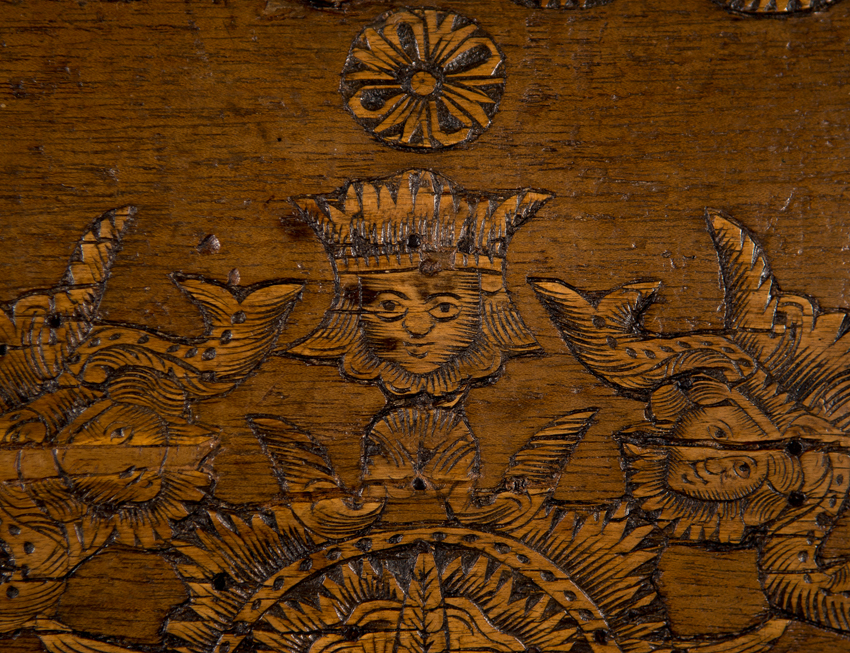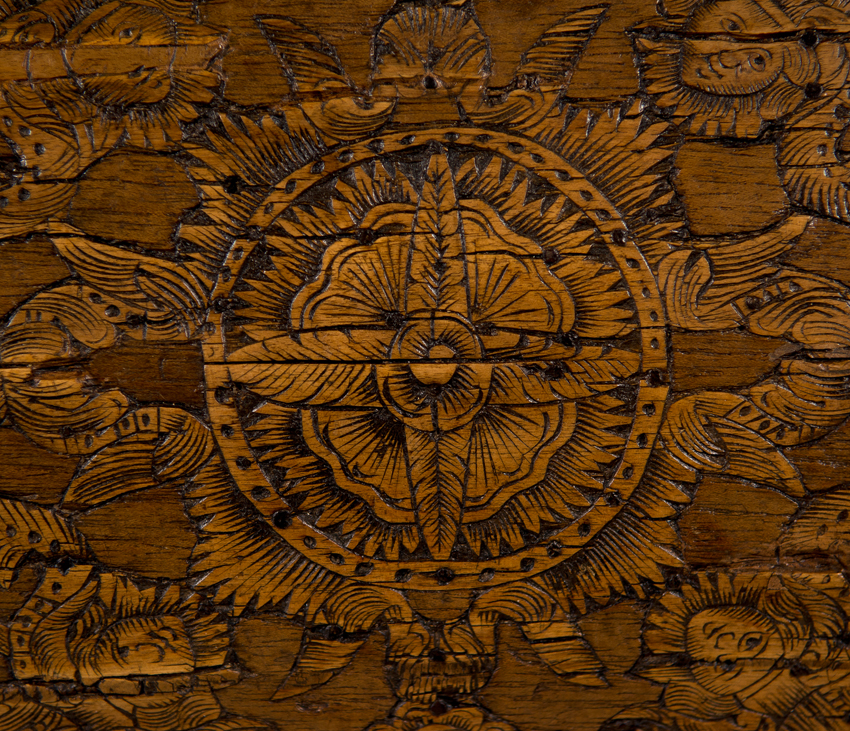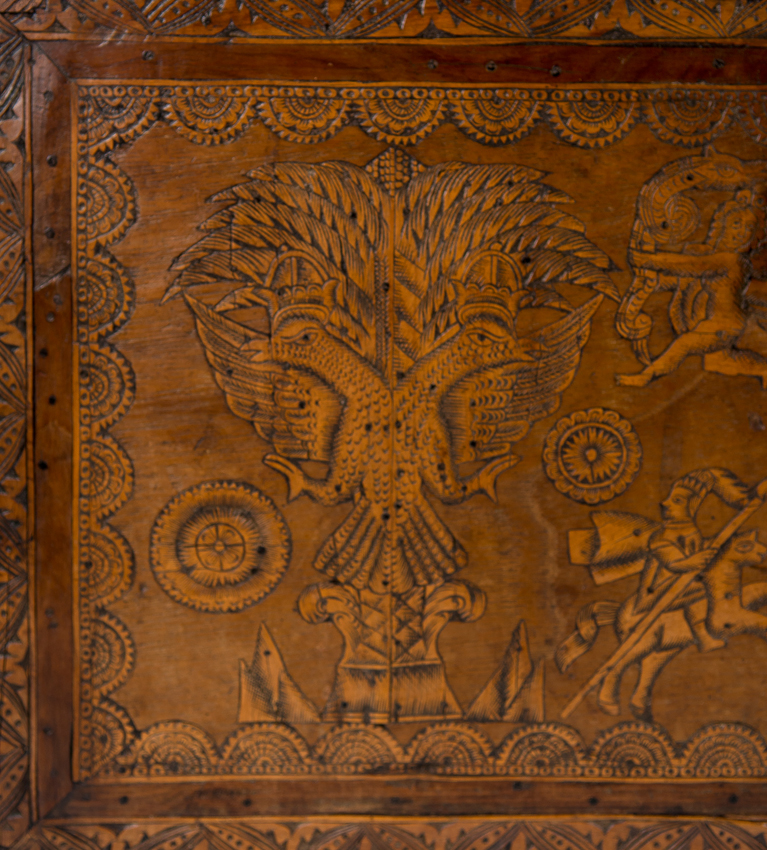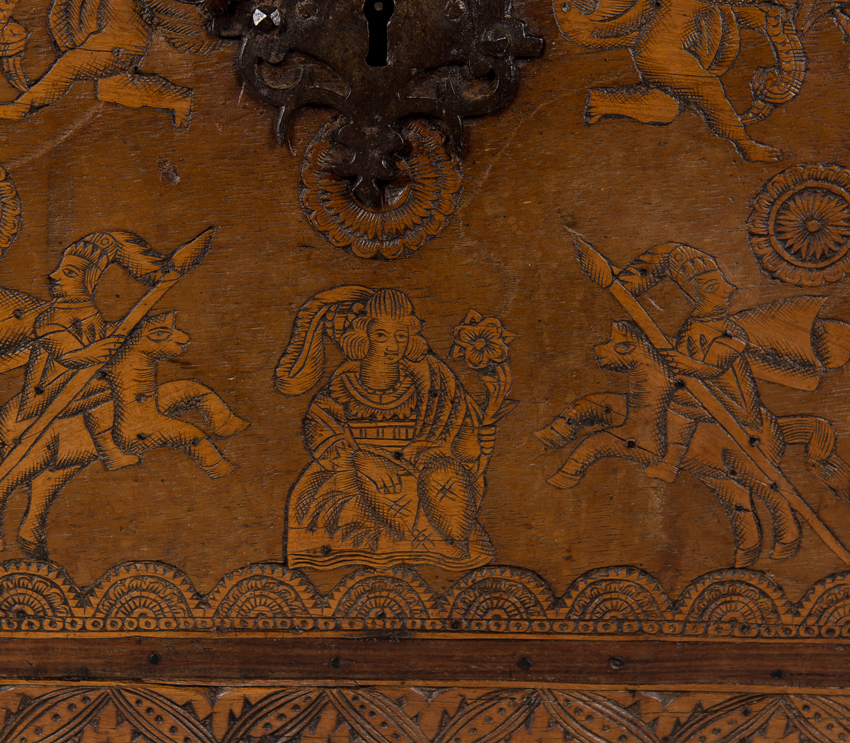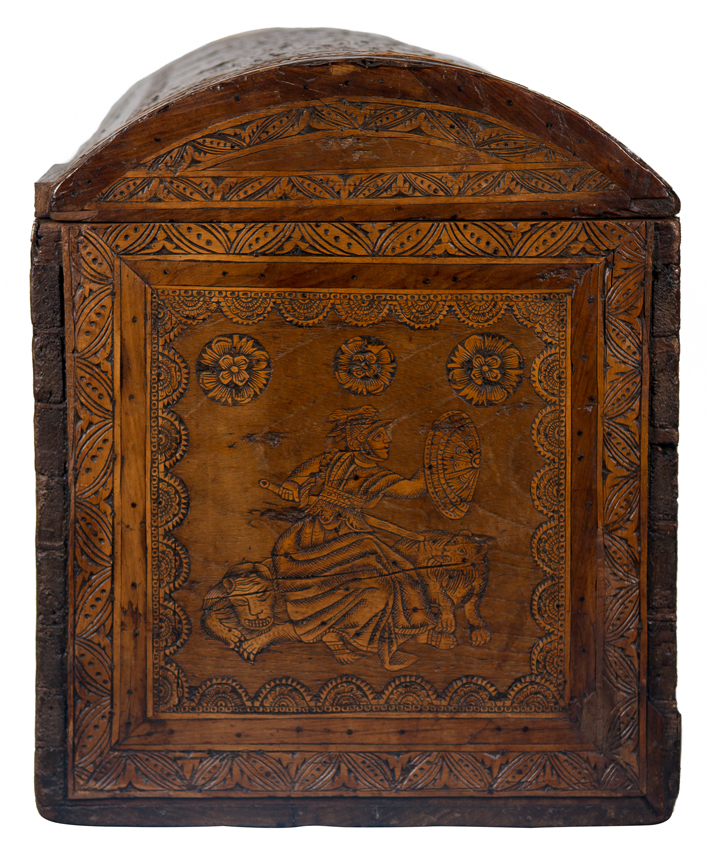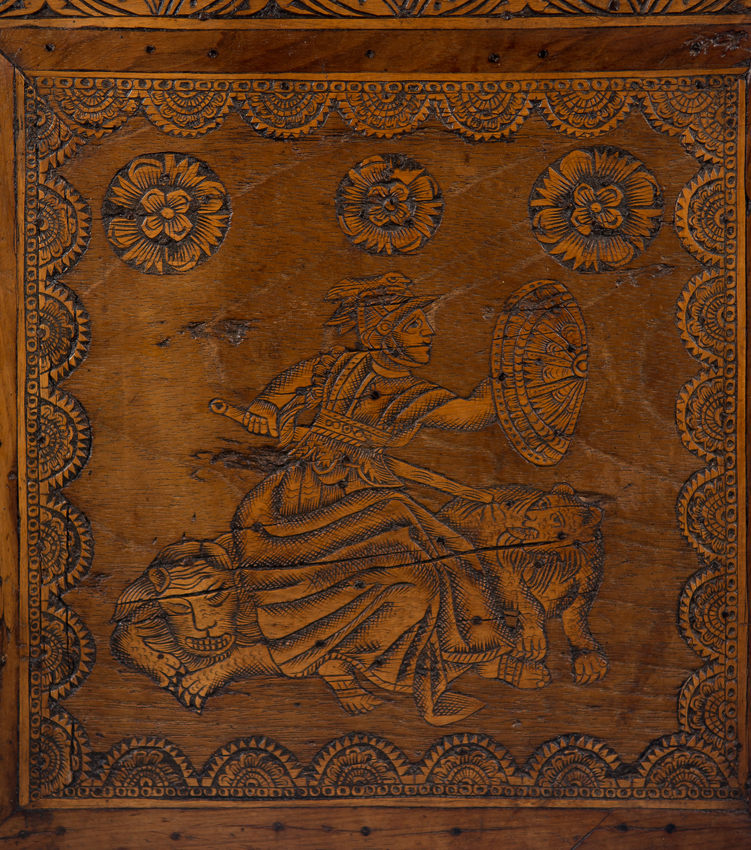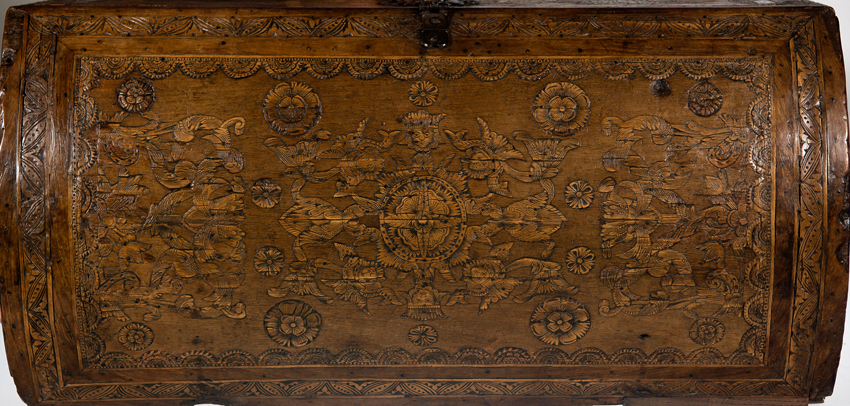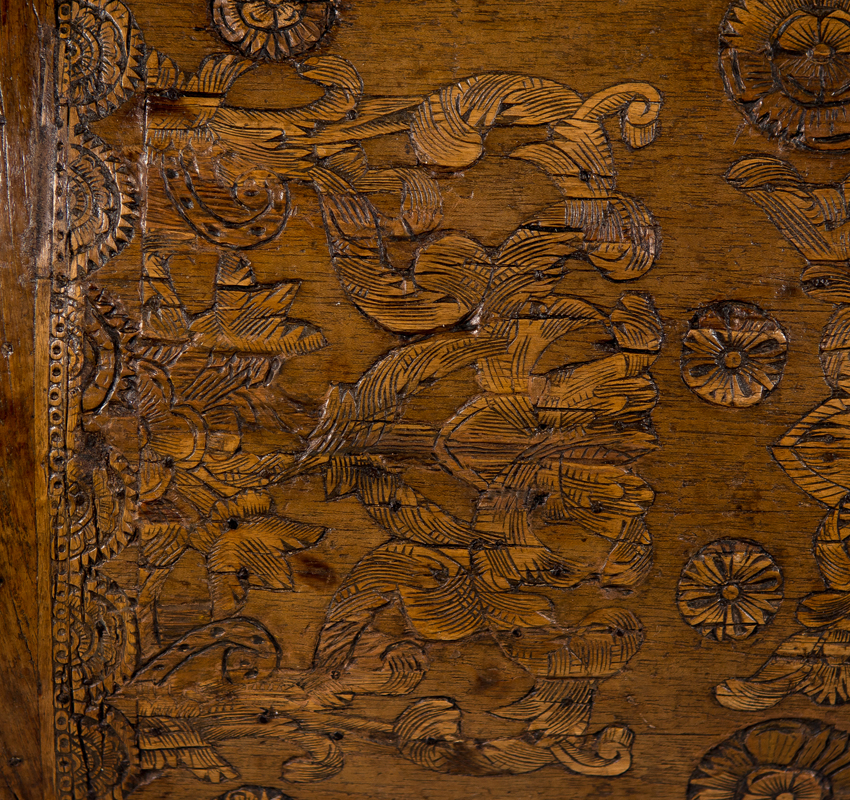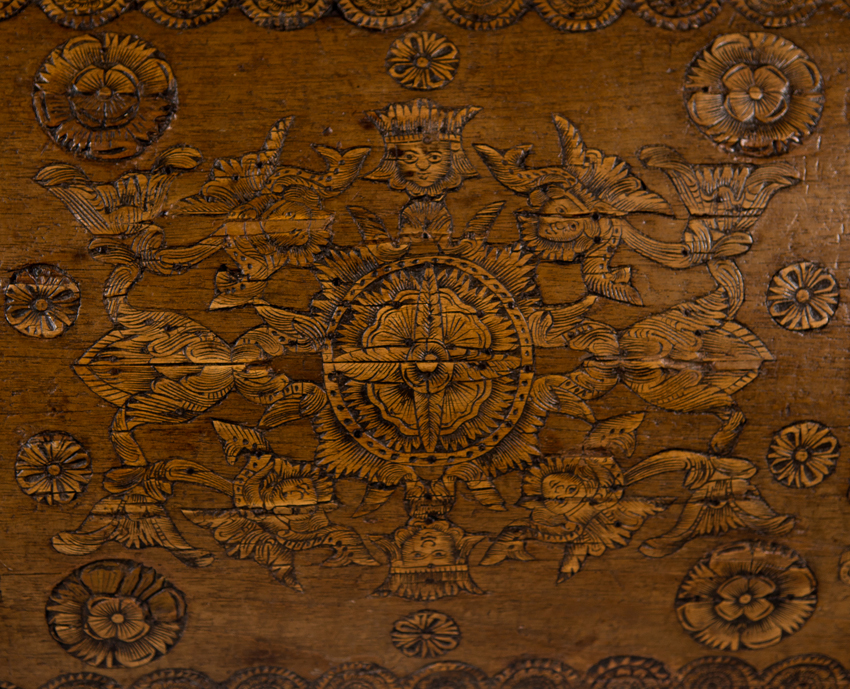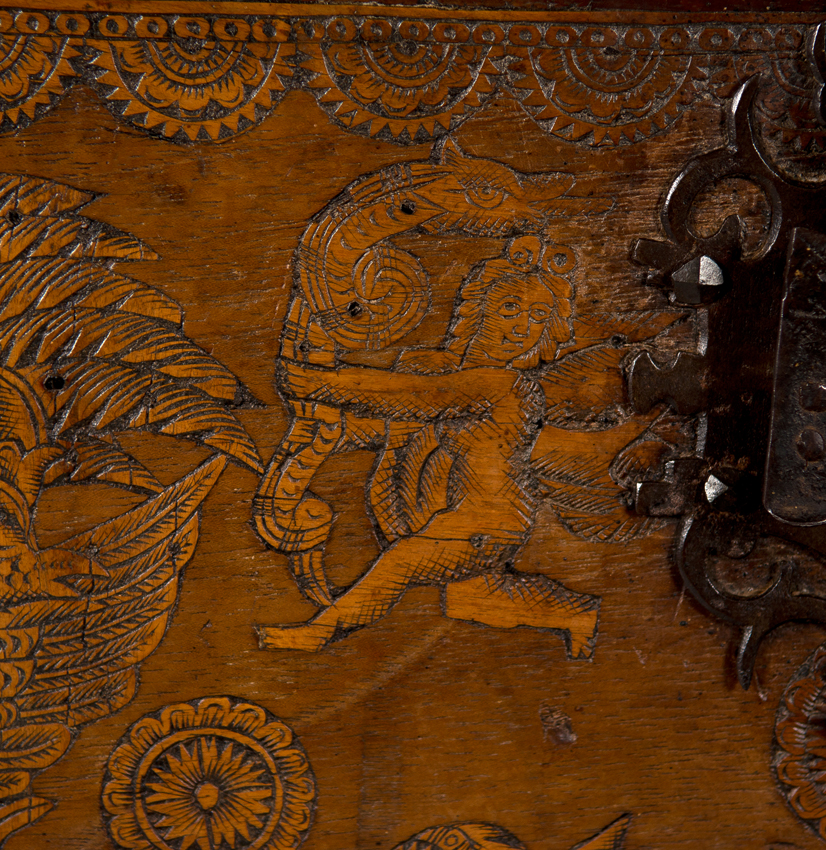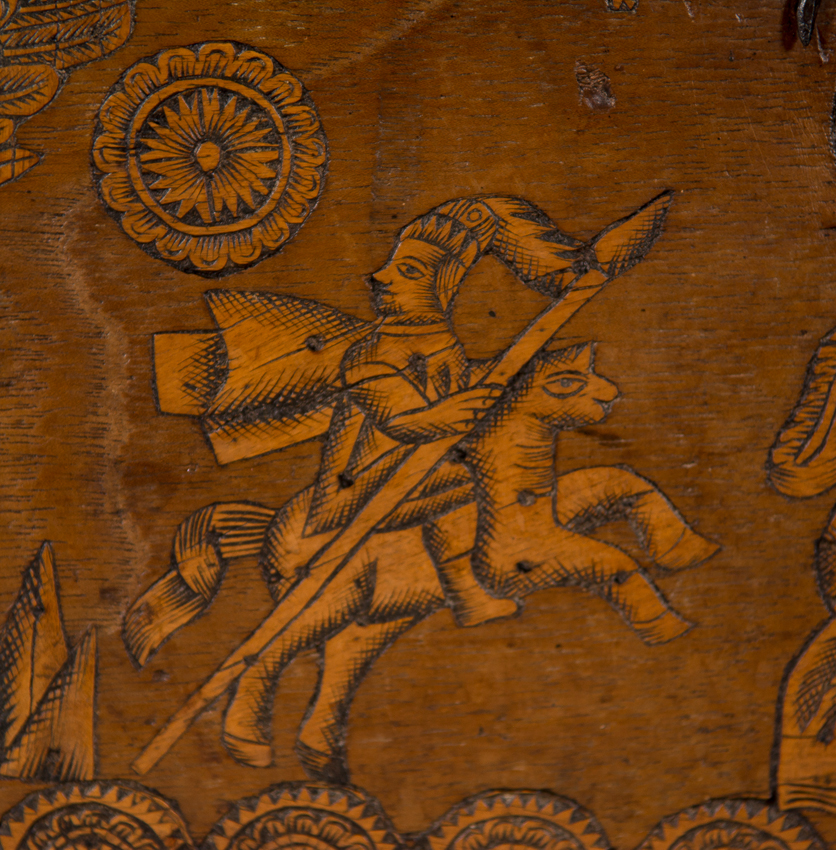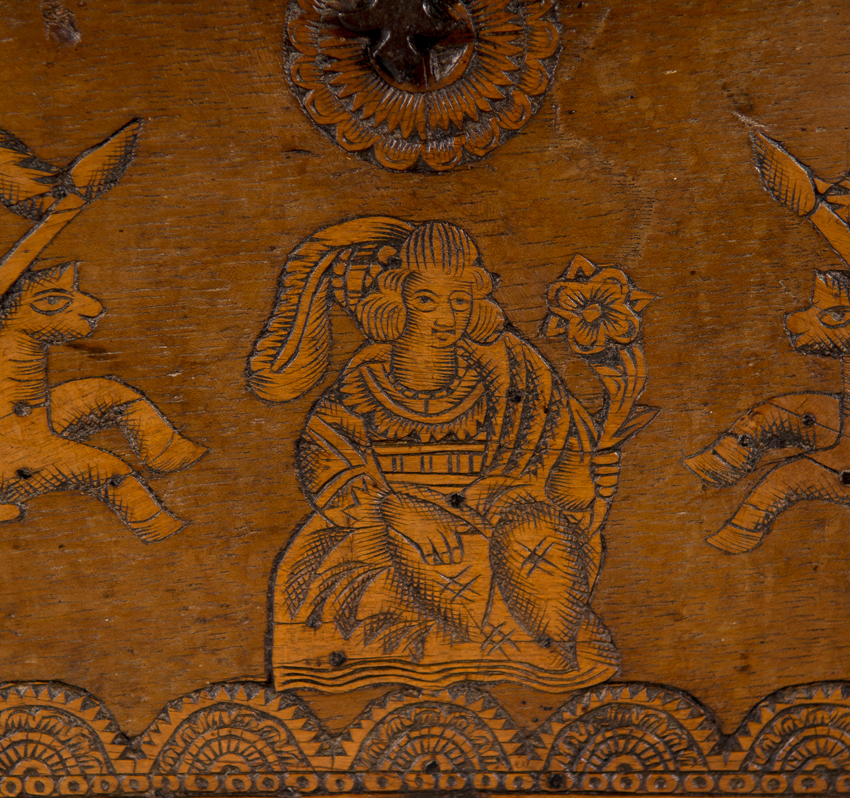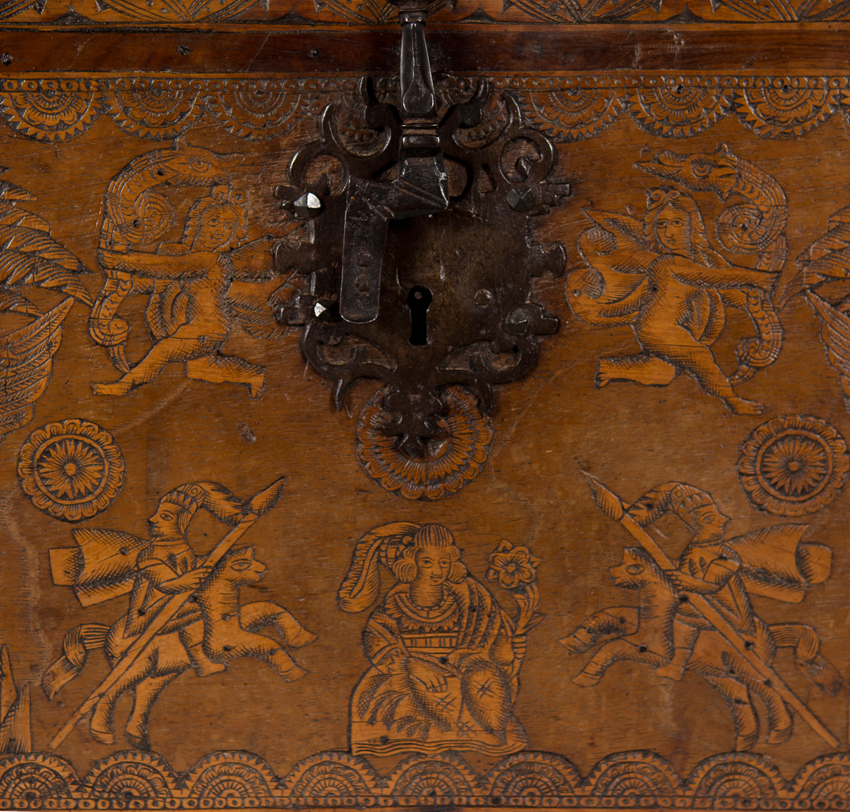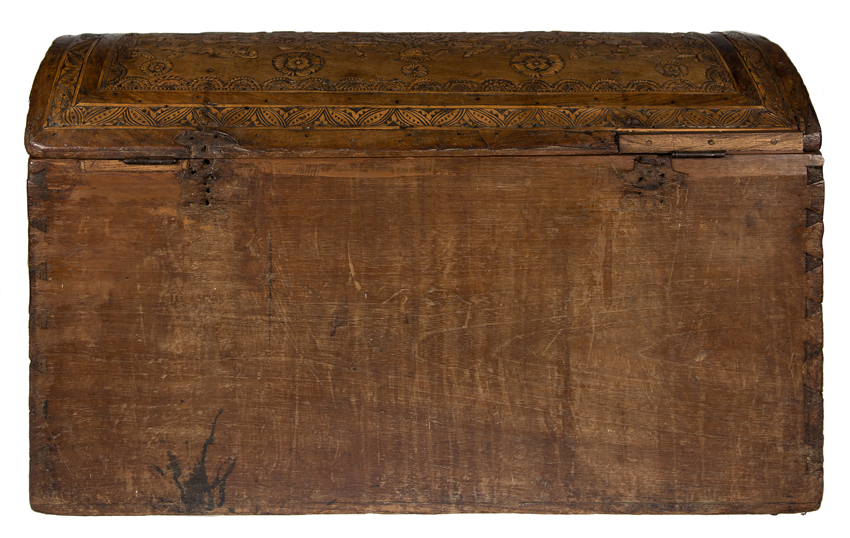50
Large, curved lidded wooden chest with inlay and sgraffito decoration using the zulaque techniq
In Millésime 24
Large, curved lidded wooden chest with inlay and sgraffito decoration using the zulaque technique and wrought iron fittings. Novo-Hispanic work. Villa Alta de Oaxaca, Mexico. 17th century.
50 x 85 x 43 cm.
This chest is unique because its entire decoration is centred around ancestral cultures predating the arrival of the Spaniards, harking back to the Aztecs. Elements of fauna and characters unrelated to those extracted from engravings from Europe can be found. This peculiarity indicates, in our opinion, a rather decided intention to showcase these origins and culture with pride, by eschewing the usual European-inspired decoration. From this, we deduce that it might have been commissioned by an important personality in Oaxacan society.
On the curved lid, in the centre, there is a rosette-like motif formed by feathers and leaves. Above and below the rosette, there is a head with a feathered crown, which could well represent Moctezuma, in our opinion; closing the circle, the same motif of a face with a curious headdress is repeated. On both sides of this central scene, there is an elaborate composition of flowers and rosettes. The upper edge of the lid is edged with a border identical to the one found on one of the two Oaxacan chests kept in Zaragoza at the Alma Mater Museum.
The front is magnificently decorated, again with a decidedly indigenous character: displaying what is probably a double-headed quetzal on a pedestal on both sides. As Paz Aguiló indicates when referring to a similar chest from Zaragoza, which is decorated with a pair of bird-like creatures similar to eagles on its lid: "it could be a pair of quetzals arranged in heraldic style, in imitation of the eagles in European decorations. This transformation of animal and plant elements taken from European engravings into something native to their environment is what truly turns the furniture from Oaxaca into the genuine expression of Novo-Hispanic style."
In the central part of the front are the figures of two indigenous people with a spear at the back of an animal that looks like a horse with a feline head, as well as two human figures catching a coiled snake. Finally, in the centre, under the magnificent iron fitting, there is a lady with a flower that could symbolise spring.
Both sides show the same motif of a warrior with shield and sword defending himself against two lions by killing them.
We see similarities between the decoration on this chest and objects of local gold and silver craftsmanship found in ancient tombs, such as the Mixtec gold and silver pectoral pieces or some more closely related to the decoration of this chest: Mesoamerican jewellery rescued from Tomb 7 at Monte Albán, located in Oaxaca itself.
This type of furniture was a clear example of the social prestige of its owners, as Gustavo Curiel indicates, as examples of Oaxacan pieces of furniture were found in the inventories of noble families.
Unlike this chest, it was more common for this type of furniture to be for export and, therefore, decorated in the taste of European clientele, who preferred allegorical, mythological, courtly, palatial, or landscape scenes, drawn from European books and engravings. As we mentioned, this influence is not reflected in the spirit that inspired the creation of this large chest in the auction.
Pieces of the same importance as this one, although without the particularity of traditional Aztec decoration, can be found in various museums. A similar one is kept in the collection at the Franz Mayer Museum in Mexico; likewise, a magnificent desk is part of the collection at the National Archaeological Museum of Madrid; the magnificent chest from Villa Alta of the Marquises of Mancera from the Gerstenmaier collection; also, the two chests, as mentioned, kept in the Alma Mater Museum in Zaragoza.
The specific and unique Oaxacan decoration technique is well explained by Mr. Andrés Gutiérrez Usillos, in “El baúl de taracea de Villa Alta (Oaxaca, Nueva España) de los marqueses de Mancera en la colección Gerstenmaier. Una obra invitada en “contexto” en el Museo de América” (The Inlaid Chest from Villa Alta (Oaxaca, New Spain) belonging to the Marquises of Mancera in the Gerstenmaier Collection. A guest piece in 'context' at the Museum of the Americas): "One of the most interesting aspects that characterise and individualise this production from Villa Alta compared to other similar carpentry is the use of sgraffito or excavation of the contours, folds, features, and shadows of the designs and figures, and their filling with a black paste called zulaque or zumaque, which would give a very similar appearance to woodcut prints [...] the technique of wood inlay and incisions or sgraffito filled with black paste, characteristics that define the Viceroyalty production of the town of Villa Alta, in Oaxaca, Mexico."
It is also interesting to read Aguiló, who explains that the technique in question is an "embossed zulaque - a bituminous paste of slaked lime and black dye extracted from logwood, with which threads are formed that are inserted into the grooves made in the wood under pressure, forming figurative decorative motifs."
Reference bibliography:
- Aguiló, María Paz. (2008). "Aproximaciones al estudio del mueble Novohispano en España". CESIC publications.
- Ramiro Reglero, Elisa. (2020). “Dos baúles oaxaqueños en el Museo Alma Mater De Zaragoza, dotación a la iglesia de Alfocea del jurista Juan Francisco de Montemayor Córdoba y Cuenca”
- Curiel, Gustavo. (Coord.). (2019). Carpinteros de la sierra. El mobiliario taraceado de la Villa Alta de San Ildefonso, Oaxaca (Siglos XVII y XVIII), Ciudad de México, Instituto de Investigaciones Estéticas, 2 vols.
Large, curved lidded wooden chest with inlay and sgraffito decoration using the zulaque technique and wrought iron fittings. Novo-Hispanic work. Villa Alta de Oaxaca, Mexico. 17th century.
50 x 85 x 43 cm.
This chest is unique because its entire decoration is centred around ancestral cultures predating the arrival of the Spaniards, harking back to the Aztecs. Elements of fauna and characters unrelated to those extracted from engravings from Europe can be found. This peculiarity indicates, in our opinion, a rather decided intention to showcase these origins and culture with pride, by eschewing the usual European-inspired decoration. From this, we deduce that it might have been commissioned by an important personality in Oaxacan society.
On the curved lid, in the centre, there is a rosette-like motif formed by feathers and leaves. Above and below the rosette, there is a head with a feathered crown, which could well represent Moctezuma, in our opinion; closing the circle, the same motif of a face with a curious headdress is repeated. On both sides of this central scene, there is an elaborate composition of flowers and rosettes. The upper edge of the lid is edged with a border identical to the one found on one of the two Oaxacan chests kept in Zaragoza at the Alma Mater Museum.
The front is magnificently decorated, again with a decidedly indigenous character: displaying what is probably a double-headed quetzal on a pedestal on both sides. As Paz Aguiló indicates when referring to a similar chest from Zaragoza, which is decorated with a pair of bird-like creatures similar to eagles on its lid: "it could be a pair of quetzals arranged in heraldic style, in imitation of the eagles in European decorations. This transformation of animal and plant elements taken from European engravings into something native to their environment is what truly turns the furniture from Oaxaca into the genuine expression of Novo-Hispanic style."
In the central part of the front are the figures of two indigenous people with a spear at the back of an animal that looks like a horse with a feline head, as well as two human figures catching a coiled snake. Finally, in the centre, under the magnificent iron fitting, there is a lady with a flower that could symbolise spring.
Both sides show the same motif of a warrior with shield and sword defending himself against two lions by killing them.
We see similarities between the decoration on this chest and objects of local gold and silver craftsmanship found in ancient tombs, such as the Mixtec gold and silver pectoral pieces or some more closely related to the decoration of this chest: Mesoamerican jewellery rescued from Tomb 7 at Monte Albán, located in Oaxaca itself.
This type of furniture was a clear example of the social prestige of its owners, as Gustavo Curiel indicates, as examples of Oaxacan pieces of furniture were found in the inventories of noble families.
Unlike this chest, it was more common for this type of furniture to be for export and, therefore, decorated in the taste of European clientele, who preferred allegorical, mythological, courtly, palatial, or landscape scenes, drawn from European books and engravings. As we mentioned, this influence is not reflected in the spirit that inspired the creation of this large chest in the auction.
Pieces of the same importance as this one, although without the particularity of traditional Aztec decoration, can be found in various museums. A similar one is kept in the collection at the Franz Mayer Museum in Mexico; likewise, a magnificent desk is part of the collection at the National Archaeological Museum of Madrid; the magnificent chest from Villa Alta of the Marquises of Mancera from the Gerstenmaier collection; also, the two chests, as mentioned, kept in the Alma Mater Museum in Zaragoza.
The specific and unique Oaxacan decoration technique is well explained by Mr. Andrés Gutiérrez Usillos, in “El baúl de taracea de Villa Alta (Oaxaca, Nueva España) de los marqueses de Mancera en la colección Gerstenmaier. Una obra invitada en “contexto” en el Museo de América” (The Inlaid Chest from Villa Alta (Oaxaca, New Spain) belonging to the Marquises of Mancera in the Gerstenmaier Collection. A guest piece in 'context' at the Museum of the Americas): "One of the most interesting aspects that characterise and individualise this production from Villa Alta compared to other similar carpentry is the use of sgraffito or excavation of the contours, folds, features, and shadows of the designs and figures, and their filling with a black paste called zulaque or zumaque, which would give a very similar appearance to woodcut prints [...] the technique of wood inlay and incisions or sgraffito filled with black paste, characteristics that define the Viceroyalty production of the town of Villa Alta, in Oaxaca, Mexico."
It is also interesting to read Aguiló, who explains that the technique in question is an "embossed zulaque - a bituminous paste of slaked lime and black dye extracted from logwood, with which threads are formed that are inserted into the grooves made in the wood under pressure, forming figurative decorative motifs."
Reference bibliography:
- Aguiló, María Paz. (2008). "Aproximaciones al estudio del mueble Novohispano en España". CESIC publications.
- Ramiro Reglero, Elisa. (2020). “Dos baúles oaxaqueños en el Museo Alma Mater De Zaragoza, dotación a la iglesia de Alfocea del jurista Juan Francisco de Montemayor Córdoba y Cuenca”
- Curiel, Gustavo. (Coord.). (2019). Carpinteros de la sierra. El mobiliario taraceado de la Villa Alta de San Ildefonso, Oaxaca (Siglos XVII y XVIII), Ciudad de México, Instituto de Investigaciones Estéticas, 2 vols.
Millésime 24
Sale Date(s)
Venue Address
General delivery information available from the auctioneer
The purchase price includes the delivery of the lots in the venue of the auction. Transporting to other destinations is at the own risk of the client. The customer must contact "LST", to give the corresponding instructions for such transporting. "LST" is not responsible for the packaging or any accident incurred during transportation.
Important Information
Once again, we start the year with a special auction, called Millésime.
A catalog of 73 lots of European, Novo-Hispanic and Vicerregal art, so spanish americas art, where you will find paintings, furniture, decorative arts etc.
We hope you enjoy it!!
Terms & Conditions
CONDITIONS OF THE AUCTION:
I. REGISTRATION. To bid in the room customers must register at the beginning, filling out a form and picking a number that will identify them during the auction. Customers may be required to register in bank references or other guarantee system and if they do not prove the solvency "LST" will not accept bids and award the auction.
II. WRITTEN BIDS. "LST" will accept written bids, which will be formalized in the form provided by the room until the day before the auction. In such auctions, the room will bid in name of the client until the maximum stated in the offer and always at the lowest possible price. If there are two or more bids for the same amount, the one placed first will have the priority. Written bids received in advance, will have priority on the day of the auction.
III. TELEPHONE BIDS. "LST" will allow telephone bids, if interested people contact "LST" days before the auction providing personal data, ID card and the phone number which will be used by the staff of "LST" to call at the time of the auction. The buyer, within all the legal rights is making an offer for the asking price, when applies for telephone bid. "LST" will not take responsibility for any technical defects beyond its control, which may prevent to contact successfully the bidder during the auction.
IV. AUCTIONEER. The auction will be conducted by an auctioneer, director of the auction will be judge and arbitrator of it with full authority in its development, will award the lots to the highest bidder and is able to settle any controversy concerning lots sale, reject bids, divide lots or group them and remover objects from the room. Will be able to, if it is deemed suitable, not accept bids on the auction. His decision will be unappealable.
V. SALE OF LOTS. The lots are awarded to the highest bidder. Once the auctioneer blows the hammer, the buyer becomes responsible of the lot purchased, exempting "LST" of liability to for any damage and / or accidents that may occur. No refunds of lots.
VI. STARTING PRICE. The amount shown in the catalogue as the starting price for each lot will be, as a rule, the minimum selling price, except for exceptional cases where a reservation may be agreed upon with the seller or it set discretionary by the room.
VII. SCALE OF BIDS. The bids are set according to the following scale:
From 50.-€ to 200.-€…………………………………………..at 10.-€
From 200.-€ to 500.-€…………………………………… …25 in 25.-€
From 500.-€ to 1.000.-€………………………………..…..….50 in 50.-€
From 1.000.-€ to 2.000.-€………………………………..…100 in 100.-€
From 2.000.-€ to 5.000.-€……………………………….….250 in 250.-€
From 5.000.-€ to 10.000.-€…………………………………500 in 500.-€
From 10.000.-€ to 20.000.-€……………………………1.000 in 1.000.-€
From 20.000.-€ to 50.000.-€……………………………2.500 in 2.500.-€
From 50.000.-€ to 100.000.-€…………………………..5.000 in 5.000.-€
From 100.000.-€ to 100.000.-€………………………10.000 in 10.000.-€
From 200.000.-€ to 200.000.-€………………………25.000 in 25.000.-€
From 500.000.-€ to 500.000.-€………………………50.000 in 50.000.-€
VIII. RIGHT OF ADMISION. "LST" reserves the right to admission to the auction room and to reject, at its judgment, any purchase order, from clients whose solvency is not duly proved as well as not to sale auctions.
IX. SALE PRICES. The successful bidder of one or more lots must pay "LST" the final sale price achieves at auction, plus the 24,5 % plus 21% VAT on the commission.
X. CATALOG DATA. The catalogue data are obtained in order to careful research and advice, however, any responsibility is afforded about its accuracy. The lots will be auctioned in the state in which they are, not accepting any claims in restorations, breakage, damage, imperfections and, even description or numbering mistakes in the catalogue, in case of it, being the burden of the buyers to make sure before the auction that the description matches with their personal opinion about respective lot. The exhibition of the lots is intended to allow a perfect review and study of them.
XI. PAYMENT AND REMOVAL OF LOTS. Payment and removal of the lots will be held no later than five days following the auction. After this period expire without having the buyer removed the lot or lots purchases, it will accrue an expense of custody of 6 euros per day on each lot.
15 days after the auction without having the buyer paid and removes the sold lots, "LST" will inform the seller and there will begin judicial proceeding in order to obtain payment. The delay in payment by the purchaser of his/her sold lots will carry an interest increase at a rate of 1,5% per month.
XII. DELIVERY OF LOTS. The purchase price includes the delivery of the lots in the venue of the auction. Transporting to other destinations is at the own risk of the client. The customer must contact "LST", to give the corresponding instructions for such transporting. "LST" is not responsible for the packaging or any accident incurred during transportation.
XIII. RIGHT OF FIRT REFUSAL AND REPURCHASE. "LST" in order to article 38 of "Ley 16/1985 de 25 Junio del Patrimonio Histórico Español" (BOE. 155 June 29, 1985), will notify in advance to the Ministry of Culture, the content of their catalogues. Concerning the lots subject to the legislation referred to in the preceding paragraph, the Administration may exercise the rights of first refusal and repurchase according to the law. "LST" will watch over the protection of Artistic, Historical and Bibliographical Heritage of Spain. For customers out of European Community, a tax for export is required by the Administration.
XIV. VALUE ADDED TAX (I.V.A). This tax will be accrued on commissions of "LST" for buyers, using the rates prevailing on the date of the auction.
XV. DATA PROTECTION. In order to the "Ley 15/1999 de 13 de Diciembre, de Protección de Datos de Carácter Personal", the client authorize "LST", the inclusion of their data in a customer file, and for the promotion by "LST" of the objects at all times the rights of access, rectification or deletion of personal data by sending the appropriate request to the following address: LA SUITE SUBASTAS, C/ Conde Salvatierra, 8, 08006. Barcelona.
XVI. EXPRESS LEGAL JURISDICTION. These Conditions are governed by and interpreted in accordance with the rules of Spanish law. The mere act of participating in the auction as seller, buyer or bidder, implies acceptance of these Terms and Conditions.
Sales operations are understood to be held at the registered office of "LST", C/ Conde de Salvatierra, 8, 08006. Any dispute shall be taken to the competent courts of Barcelona, expressly waiving any other jurisdiction, in accordance with Article 55 of the "Ley de Enjuiciamiento Civil".




































